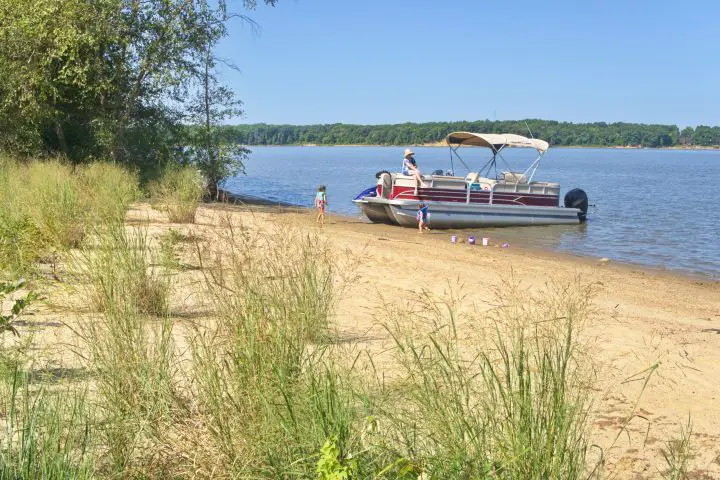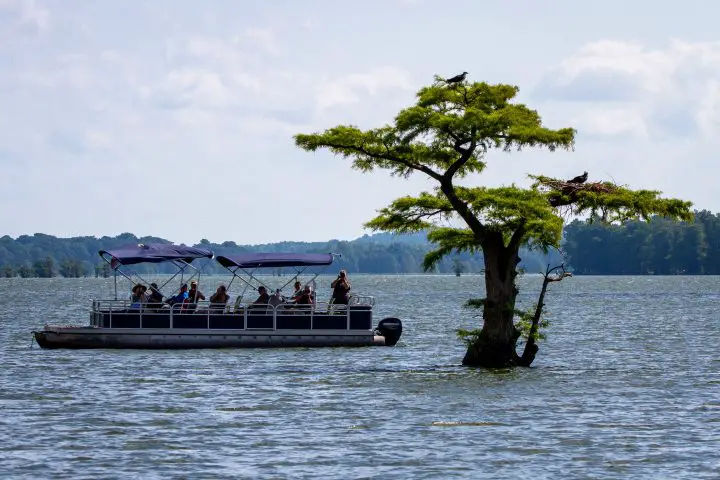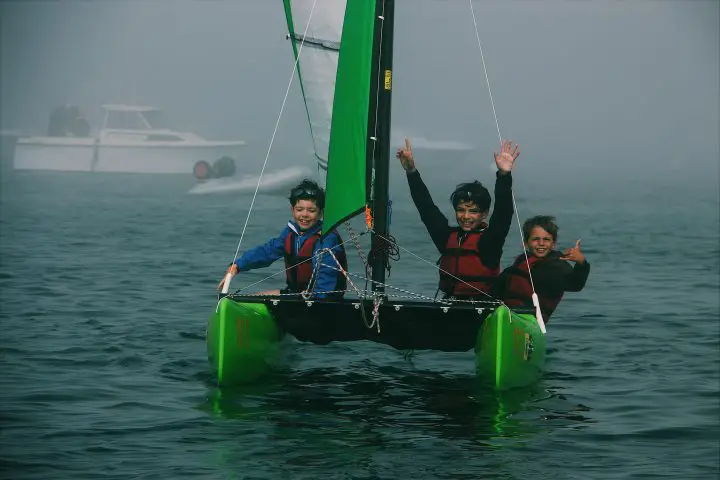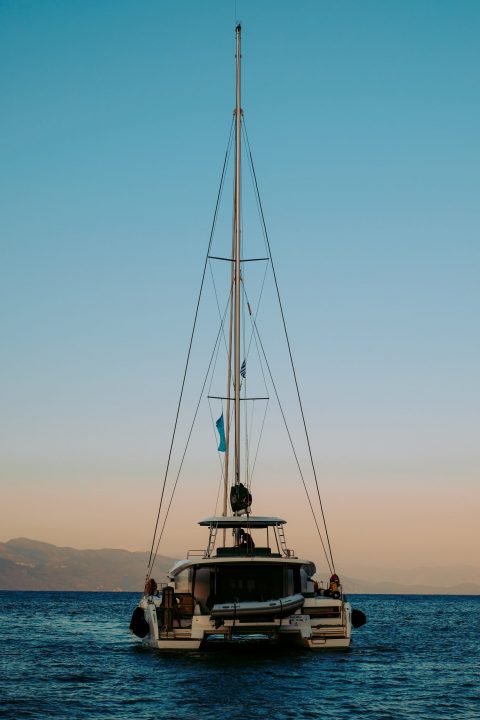Boating is often a hobby associated with particular words and unique sailing jargon. Catamaran and pontoon boat are two terms that newcomers often get mixed up.
Let’s take a look at these two very different types of boats!

Table of Contents
- Catamaran vs Pontoon Boat
- Similarities and Differences of the Two Boats
- Pros and Cons of Each
- Boat Definitions
- What Is a Pontoon Boat?
- What Are Catamarans?
- Which is Best for What?
- Is the Pontoon or Catamaran Right For You?
- Catamaran vs Pontoon FAQs
Catamaran vs Pontoon Boat
Before we get into detail, here’s a summary of the two boats:
| Feature | Catamaran | Pontoon Boat |
|---|---|---|
| Construction Material | Usually fiberglass | Mostly aluminum pontoons with aluminum frames and a deck (plywood or aluminum) |
| Hull Design | Two hulls, offering stability and space for cabins, heads, or storage | Two or three aluminum tubes (pontoons) providing buoyancy |
| Propulsion | Can be sail or power-driven, with designs for racing, cruising, or fishing | Always power-driven, typically with outboard motors |
| Use Cases | Ranging from small fishing boats to large yachts for cruising long distances. Can handle open seas | Designed for sheltered waters like lakes, bays, rivers. Ideal for day trips, fishing, or lounging |
| Deck | Bridgedeck connecting the two hulls, integrated into the boat’s structure | Open deck, can be customized with furniture for various purposes |
| Accommodations | Can include cabins, heads, and extensive storage. Larger models offer luxurious living spaces | Smaller models are open; larger can include amenities like bathrooms. Houseboats can be built on larger pontoons |
| Stability & Handling | Designed to handle rougher seas, more stable due to two-hull design | Best kept to protected, calm waters due to smaller pontoons and less stability in large waves |
| Cost | Generally more expensive due to construction and materials | Relatively inexpensive, especially when compared to fiberglass boats |
| Variations | Wide range, including power and sailing options, from small to yacht-sized | Less variation, mostly differ in luxury, performance, and size. Some have three pontoons (tri-toons) for more stability |
Similarities and Differences of the Two Boats
Here’s a table that compares catamarans and pontoon boats based on various common points:
| Aspect | Catamaran | Pontoon Boat |
|---|---|---|
| Design and Structure | Twin hulls that reduce drag and improve stability. Often made of fiberglass or composite materials. | Consists of two or more aluminum tubes (pontoons) supporting a flat deck. Generally made of aluminum. |
| Stability and Maneuverability | High stability due to wide beam. Good maneuverability, especially in open waters. | Very stable at rest and at low speeds due to the wide platform, but less maneuverable in tight spaces. |
| Performance and Speed | Generally faster and designed for higher performance, especially in sailing catamarans. | Designed for leisurely cruising; slower compared to catamarans. |
| Size | Range from small day sailers to large liveaboard vessels. | Typically smaller than catamarans; mainly used for day trips and entertaining a small group. |
| Where to Sail | Suitable for both coastal cruising and open ocean passages. | Best suited for lakes, rivers, and coastal waters with minimal wave action. |
| Ease of Use | Requires more skill to sail, especially larger models. Power catamarans are easier for motor boating. | Generally easier to operate, making them popular among beginners and casual boaters. |
| Price Differences | Generally more expensive due to their size, design, and materials. | More affordable, with pricing that appeals to a wide range of budgets. |
| Maintenance | Can be higher, especially for sailing catamarans, due to rigging and marine systems. | Typically lower maintenance, especially with aluminum hulls that resist corrosion. |
| Value/Resale | Often retains value well, especially well-maintained models from reputable brands. | Depreciates faster but can hold reasonable value if well-maintained and in demand. |
| Accessibility | Can be less accessible due to size and docking requirements; larger models may require specialized marinas. | Highly accessible due to their versatility, size, and ease of docking in various locations. |
| DIY | DIY repairs and upgrades can be complex due to advanced systems and construction materials. | More conducive to DIY repairs and upgrades due to simpler design and construction. |
| Purpose | Designed for a range of purposes from racing, cruising, to living aboard. | Primarily used for leisure activities, including fishing, swimming, and entertaining. |
Of course, your actual experience with either type of boat can vary depending on specific models, manufacturers, and individual preferences. This is just a general comparison.
Pros and Cons of Each
| Boat Type | Pros | Cons |
|---|---|---|
| Catamaran | – High stability due to wide beam and twin hulls – Good performance and speed, especially for sailing models – Spacious living quarters, suitable for long voyages – Reduced drag and efficient fuel consumption for power catamarans – Excellent maneuverability in open waters – Often have a shallow draft, allowing closer access to shorelines | – Generally more expensive to buy and maintain – Requires more skill to operate, especially sailing models – Larger size can limit docking options – Can be more complex to handle in tight marina spaces |
| Pontoon Boat | – Very stable at low speeds and when stationary, making them great for socializing – Generally more affordable and cost-effective – Easy to operate, making them ideal for beginners – Versatile for various activities (fishing, sunbathing, entertaining – Shallow draft allows access to a wide range of waterways – Typically lower maintenance costs. | – Lower performance and speed compared to catamarans – Not designed for rough waters; best suited for calm lakes and rivers – Can be less maneuverable, especially in tight spaces – Less suitable for long-distance or open ocean voyages – Aluminum pontoons can be susceptible to damage from impacts or corrosion if not well-maintained |
Boat Definitions
Before we look at the types of each, let’s first think about exactly what we’re talking about when we describe these types of vessels. When you look at them and describe them, they appear similar. However, there are some differences, and they are very different types of boats!
Pontoon Boats
Pontoon boats are small, open-deck boats built on aluminum pontoons. They are always power-driven (usually with outboard motors) and typically small enough to fit on a trailer. Designed for sheltered waters like lakes, bays, rivers, or coves, they’re usually designed for day trips.
Catamarans
These are fiberglass (usually) boats with two hulls. They may be power or sail and might be set up for racing or cruising. They might be small saltwater fishing boats or huge yachts designed to cruise long distances.
What Is a Pontoon Boat?
The most common style of pontoon is mostly found on inland lakes and rivers. They have two simple aluminum tubes connected by a plywood deck platform. The tubes, or pontoons, provide nothing but buoyancy to keep the deck afloat.
Usually, most pontoon boats are outfitted for fishing or general hanging out on the water. Because of their small pontoons and lack of stability should a large wave come over the deck, pontoons are best kept to protected and mostly calm waters.
This is why they’re perfect on lakes or bays where a moderate chop is the roughest thing you’d ever encounter.
Of course, there is some variation in the basic design and construction. Some are “tri-toons” with three pontoons, the center providing more stability and a better ride. There are fiberglass pontoon boats. Some have a completely open deck with lounges and chairs, while others have an enclosed area. Sometimes custom houseboats are built on pontoon boat frames, or at least with the same general construction.
If there’s one thing that differentiates pontoon boats from catamarans, it’s that there’s no such thing as a sailing pontoon boat.
We started with the pontoon boat because that is the vessel that most people are more familiar with.

Types of Pontoon Boats
There’s a little less variation in the world of pontoon boats. Nearly all manufacturers make boats that look very similar to one another. The pontoon tubes are nearly all aluminum, and the flat boat’s deck that connect them are nearly always aluminum frames with an open, carpeted deck. Then, furniture is put on the platform to customize it for various purposes.
Standard pontoon boats are a common sight on lakes and rivers where there’s no need for a more expensive “bluewater” boat. One of the biggest advantages of the pontoon boat is that they are relatively inexpensive—at least when compared to fiberglass boats.
Like anything, there are variations in the basic pontoon design. Some are built to be more luxurious, with better seating and accommodations. Some, like the new Manitous, use fiberglass hulls and decks to improve the fit and finish and add a premium feel. Some are built for maximum performance, with high-powered, multi-engine outboard setups.
- Party pontoons – These pontoons are designed for entertaining large groups of people. They have lots of open space, cup holders, and often feature amenities like sound systems, bars, and waterslides.
- Fishing pontoons – Fishing pontoons are optimized for fishing with features like livewells for keeping bait and catch alive, mounting points for fishing gear, casting decks, and storage for tackle.
- Performance pontoons – Performance pontoons sacrifice some space for speed. They have narrower diameter logs and may have specialty lifting strakes or strakes to allow them to go faster while still maintaining stability.
- Tritoons – Tritoons have three logs instead of the standard two seen on most pontoons. The extra log provides even more stability at anchor or at low speeds.
- Luxury pontoons – Luxury pontoon boats focus on comfort features. They have plush seating, upscale sound systems and entertainment centers, added storage and capacity for supplies needed for extended trips, and premium fit and finish.
And, of course, you can build pretty much anything on the flat deck of a pontoon. Smaller models are usually left open, with seating and lounges fore and aft. Fishing models include swivel chairs and an open casting area. A pontoon boat with bathroom might have a pop-up privacy curtain or a small changing area and toilet built into the console.
Larger pontoons are used to frame up houseboats. Many houseboat manufacturers custom-build their vessels to suit the area where they are used. Pontoons are a common method of production.
What Are Catamarans?
Now let’s look at catamarans. Catamaran boats can be sail or powered and range from small to 100-plus-foot yachts.
Instead of being built of separate parts, most catamarans are built from a single-piece, molded fiberglass shell. This shell is shaped to have two hulls, one on each side. Each hull looks like a typical boat hull, only smaller and narrower. The deck that connects the two hulls is integrated and is called the bridgedeck.
Unlike a pontoon, the hulls are open in a catamaran. Depending on its size, they might have cabins, heads (bathrooms), or general storage. On large cats, a person can walk around one hull, up some stairs, through the main salon, and down some more stairs into the other hull.

Types of Catamarans
There is a huge variation in the types of catamarans, or “cats.” You can roughly differentiate them into power cats and sail cats.
Power Catamarans
If you compare power cats to pontoon boats, the closest approximation is the offshore saltwater fishing catamaran. Like the World Cat and Glacier Bay, these boats are outboard fiberglass boats designed for coastal day trips and can handle some rough seas. They’re usually built for fishing but can also be used for diving or cruising. Most are center console, dual console, or cuddy cabin layouts.
These boats are built to handle offshore conditions and are much safer in waves and chop than a pontoon boat is. You’ll generally see them in coastal waters where fishing boats are the go-to for long days on the water. Here’s a great discussion about these boats and how hull design matters.
There are also cruising power cats of every size and description. These boats have two hulls, each with staterooms and heads. The salon is built on the center bridgedeck. There is usually an aft cockpit for entertaining and an upper fly bridge area for relaxing and driving in the sun.
Power cruising cats, like the Leopard or the Fountaine Pajot power series, are generally based on sail catamaran designs that have been converted to power. These boats cruise around 18 knots and offer more accommodations and a more stable ride than a monohull cruising boat of similar length. The smallest models are usually about 30 feet long, while the largest can be big enough to be classified as a yacht. The Lagoon Seventy8 is a good example of a power catamaran yacht.
Sailing Catamarans
The original catamarans were built by the Polynesian cultures many centuries ago. These seafarers crossed great distances on traditional wood rafts built on simple floats make from two logs. Modern multihulls take their designs from these early vessels, but modern materials and production mean they are marvels of modern engineering.
The most basic example of a sailing small catamaran is the ubiquitous beach cat you’d see at an island resort. These fun machines are nothing more than two fiberglass hulls connected with a wing structure and nets. Since they have very little hull under the water, they can get going very fast. The beach cats built by Hobie are the most common examples. Many examples of larger racing catamarans have been built to show just how good a cat’s sailing capabilities can be when it comes to speed.
Cruising cats are larger and heavier. Instead of being built for speed, they’re usually built to carry passengers comfortably and safely in open seas. They’re still faster than monohull sailboats of similar lengths, however.
They have big hulls that house the living quarters—the staterooms, heads, and all the storage a cruiser needs. They are very popular with charter companies since one small catamaran can comfortably accommodate several couples and provide private staterooms for everyone on board.
Their comfort is notable for several reasons, especially if you compare them to monohull sailboats. They have much more storage space and much more comfortable living space. The salon is on the bridgedeck and usually features large windows providing light and ventilation. They have huge cockpits that are great for gathering with your friends for sundowners. They don’t heel like a monohull does when sailing, which makes living aboard long-term much more comfortable. Catamarans have become immensely popular with folks who live onboard their boats full-time and cruise long distances.
Other types are:
- Racing Catamarans – Performance is the focus. They have lightweight, high-tech hulls and rigs and often use carbon fiber composites. Well-known brands are Gunboat and Catana.
- Folding & Trailerable Catamarans – Smaller cats that can be trailed by a car and feature folding amas (outer hulls) for towing and storage. Common brands are Dragonfly and Schionning.
- Multihull Sailing Yachts – High-performance cruising cats from companies like Sunreef that blur the lines between chartering and racing oriented designs.
- Houseboats – These „floating cottage“ designs focus on maximum onboard living space over performance.

Which is Best for What?
- Pontoon Boats are the best choice for leisure activities, day trips, fishing, and watersports, especially if you’re seeking a budget-friendly option that’s easy to use.
- Catamarans excel in sailing, cruising, long voyages, and the liveaboard lifestyle, offering greater performance, stability, and living space, ideal for those with a higher budget and sailing experience.
| Purpose | Pontoon Boats | Catamarans |
|---|---|---|
| Leisure & Entertainment | Best suited – Pontoons are ideal for leisure activities like sunbathing, entertaining, and swimming. | Good – Catamarans offer spacious decks and comfortable lounging areas but are typically more expensive. |
| Fishing | Best suited – Their stable platform and open deck space make them excellent for fishing. | Good – Depending on the design, some catamarans can be well-equipped for fishing but might be overkill. |
| Sailing & Cruising | Less suited – Pontoons are not designed for sailing. | Best suited – Catamarans are specifically designed for sailing and long cruises, offering speed and comfort. |
| Watersports | Best suited – Ideal for calm water sports like tubing and water skiing due to stability. | Good – Catamarans can also be used, especially power catamarans, but are generally more expensive. |
| Day Trips | Best suited – Perfect for short, leisurely day trips with family and friends. | Good – Catamarans are also suitable but might be more than needed for simple day trips. |
| Long Voyages | Less suited – Not designed for long or open sea voyages. | Best suited – Catamarans are excellent for long voyages, offering ample living space and stability. |
| Exploring Shallow Waters | Best suited – Their shallow draft allows access to shallow areas without risk of grounding. | Good – Many catamarans also have a shallow draft, allowing them to explore near shorelines. |
| Liveaboard Lifestyle | Less suited – While possible, pontoons offer limited space and amenities for long-term living. | Best suited – Catamarans are often designed with liveaboard amenities, providing comfort and space. |
| Budget-Friendly Boating | Best suited – Generally more affordable in purchase price and maintenance. | Less suited – Catamarans are usually more expensive to purchase and maintain. |
| Ease of Use | Best suited – Simple to operate, making them great for beginners. | Good – Catamarans require more skill, especially sailing models, but power versions are quite user-friendly. |
Is the Pontoon or Catamaran Right For You?
Hopefully we were able to clarify these two sailing terms.
Picking the right boat is always a challenging endeavor. But pontoon boats and catamarans are very different, and chances are you have a pretty good idea of which camp you’re in.
In the end, remember—every boat is built to serve a purpose. Figure out your purpose and how you want to use your boat. Then find the boat that fills the need.
Catamaran vs Pontoon FAQs
Are catamarans good in rough water?
It depends on the catamaran in question. Catamarans are more comfortable in a chop than most other boats because they rock side to side less. They still pound into waves and sometimes produce an uncomfortable, jarring motion as the two hulls get bashed separately by each wave. Some people prefer the motion of catamarans at sea, while others prefer the motion of standard monohulls.
Regarding safety, most catamarans are built with large safety factors that make capsizing unlikely. The difference, however, is that once a catamaran capsizes, it cannot right itself and will remain upside down. A sailing monohull, on the other hand, will self-right.
Is a catamaran more stable than a boat?
There are different types of stability. Catamarans have very high initial stability, meaning it takes great force to get them to heel or roll. Monohulls have less of this type of stability, so they tend to roll from side to side more.
However, nothing keeps the catamaran upright once a cat rolls too far. A monohull sailboat’s low-hung, heavy keel will force it to return upright, even if the boat is completely knocked down. A catamaran will capsize and remain upside down in the water. This is uncommon on modern cruising catamarans, which are built for maximum stability. But it does happen and probably happens more than many sailors realize.
Why catamarans are better?
Catamarans are popular choices with boaters because they provide a more stable ride. Whereas monohull boats tend to roll back and force, a catamaran remains more upright and experiences less of that roll. Cats also provide more space and better accommodations than a similar-length monohull.
What are the disadvantages of catamaran?
Catamarans are larger and more complex than similar-sized monohull boats and, therefore, more expensive. Two engines mean that catamarans require more maintenance, as well. And, depending on where you boat, it can also be hard to find marina slips and maintenance facilities that can handle a large catamaran. Their wide beam means you’ll need special boat lifts and side-tie slips—things that are sometimes hard to find.

